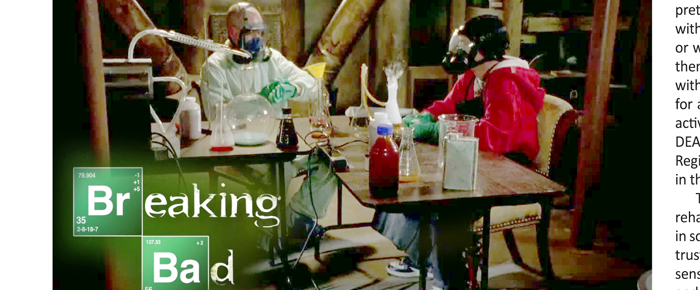
By Bruce Cathcart
You have rented your house out to a seemingly very nice young man whose high school chemistry teacher was diagnosed with 3rd stage lung cancer and convinces him (when their mobile RV laboratory won’t start) to cook methamphetamine in the basement of YOUR home. Sound familiar?
Each year thousands of homes that have been used as meth labs are sold to unsuspecting buyers across the U.S.A. “Cooking” or even smoking meth inside a home leaves behind hazardous chemicals such as iodine, mercury, lead, lithium, and other poisons, that permeate the walls, ceilings, insulation, floors and carpets. It is estimated that for every one pound of meth that is manufactured in a home it leaves behind five pounds of hazardous waste. Exposure to even small amounts of these poisons can damage the human nervous system, liver and blood especially in small children. Babies still in the womb if exposed can have birth defects and developmental problems. Early signs for adults living in a home with meth contamination can include nosebleeds, migraines, and mouth sores. This is very dangerous stuff we are dealing with here.
There are no federal rules that require sellers/landlords or their agents to disclose a home’s meth lab history. The state of California does have a specific law that requires a seller to disclose in writing to a buyer a “pending order” issued by a local health officer prohibiting the use or occupancy of a property contaminated by meth activity. But if only 1 out of 100 meth labs are ever busted the odds are against having a pending order issued on the home you are looking to buy. There is also a law that requires sellers/landlords to disclose to buyers/tenants any known hazards existing on the property, as well as a duty on both the seller/landlord and their agents to disclose any and all known material facts that can affect the property. Clearly the key word here is “known”. If they have no knowledge of any prior meth activity they cannot be held responsible to disclose what they do not know. There is also no requirement that a house be tested for meth lab activity. Ultimately it is the responsibility of the buyer to inspect, test, and discover if the home was used as a meth lab on the buyer.
For concerned buyers there are several do-it-yourself testing kits that I found online ranging from $10.00 to $50.00 and one for $109.00 that includes 3 tests. Since most meth contaminated houses have no odor or visual signs it makes sense that if you are going to test a house that you do it in more than one spot. These DIY kits are reliable if they test positive for meth, but if they do not there is no guarantee that the house is safe. The only way to be certain is to hire a professional inspector which can cost anywhere from $500.00 to over $2,000.00.
There are other things a buyer can do besides testing to help determine if a home may have been used as a meth lab. I always recommend to potential buyers that they talk with the neighbors BEFORE they close escrow on their new home. These folks will have a pretty good idea of what went on in the home with the previous occupants. If the sellers are or were last occupying the property ask about them and see if any red flags go up. Checking with the police and county health departments for any complaints, reports filed, or suspicious activity at the home is also a good idea. The DEA even has a National Clandestine Laboratory Register… but I checked it out and only 7 homes in the Coachella Valley were on this list.
The cost to test, clean up, decontaminate, rehabilitate, and then retest is never cheap and in some cases can exceed $100,000.00. Always trust your instincts and use your common sense. If you are at all concerned make sure and get the property tested before you close escrow.
This week’s real estate tip: Most meth contaminated houses have no odor or visual signs, but sometimes they do. Unexplainable problems like yellow stained carpet and walls or eroded plumbing and electrical might be evidence of chemical cooking inside the home. Obviously rubber gloves and tubing, dust/gas masks, scientific glassware, coolers and camp stoves left behind are a pretty good indicator. But also a combination of empty or full containers of acetone, muriatic acid, brake cleaner, drain cleaner, iodine, phosphorus, ether, battery acid, lye, lantern fuel, propane canisters or antifreeze can also be signs of a meth lab on site. Use extreme caution here and if appropriate call the meth hotline at 1-888-NO-2-METH.
Bruce Cathcart is the Broker/Co-Owner of La Quinta Palms Realty, “Your Friendly Professionals” and can be reached by email at laquintapalms@dc.rr.com or visit his website at www.laquintapalmsrealty.com.











































